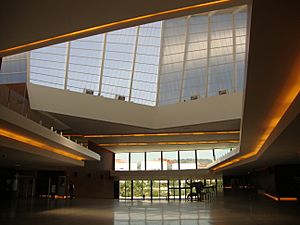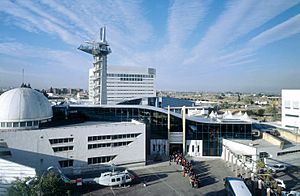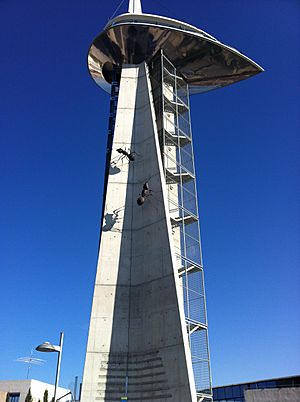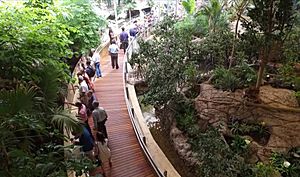Parque de las Ciencias (Granada) facts for kids
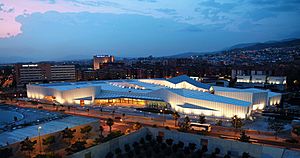
Parque de las Ciencias, view of Macroscopio building
|
|
| Established | 8 May 1995 |
|---|---|
| Location | Granada, Andalusia, Spain |
| Type | Science museum |
The Parque de las Ciencias (which means "Science Park") is an amazing science center and museum in Granada, Spain. It's part of a big group called the European Network of Science Centers and Museums (ECSITE). This huge place is about 70,000 square meters, which is like 10 football fields! It has tons of cool things to see and do.
You can explore permanent and temporary exhibits, visit a planetarium, and learn in special educational areas. There are also places to eat, a bookstore, a library, and even cinemas. Plus, the Parque de las Ciencias has unique labs for things like plastination and workshops where they create and fix exhibits.
Contents
Exploring the Parque de las Ciencias
The Parque de las Ciencias has several buildings and outdoor areas. Each part offers different ways to learn about science.
The Macroscopio Building
The Macroscopio building is a newer part of the Parque de las Ciencias. It was designed by architect Carlos Ferrater. This building has a large entrance hall that leads to many exciting exhibition areas.
Journey to the Human Body Pavilion
This pavilion helps you understand how your body works. It covers health and life sciences. People are more interested in these topics today. This is because we have more free time, better education, and live longer.
The pavilion shows you all about the human body. You can learn about anatomy, your senses, and how new medicines work. It also covers genetics, nutrition, and how long people live. This hall connects many different science fields. It helps you get a full picture of health and life.
Learning about the human body has always been a big challenge. This knowledge helps scientists research illnesses. It also helps them understand problems that cause suffering. The history of medicine shows how curious humans are. It also shows our wish to be healthy.
The hall also has exhibits on science tools. You can see how scientists study the body. There are models, recordings, and photos. You can also see modern ways to examine the body. These include microscopes and digital simulations. The exhibits mix old historical items with real organs. There are also interactive experiments and virtual reality.
Risk Prevention Hall
This hall is a fun place to learn about safety. It has many exhibits that show different risks. These are risks we might face every day. The exhibits use things that are easy to understand. These include simulators, symbols, and videos.
You walk through different paths. Each path shows situations with risks. These risks can harm your body. They are grouped by different jobs or social areas. Each path shows how our bodies can be hurt. This can be physically or mentally. This pavilion won an award in 2013.
Al-Andalus and Science Pavilion
This pavilion brings to life old scientific ideas. It shows the amazing science and technology from the time of Al-Andalus.
Techno-Forum Pavilion
This area is all about new technologies. It explores innovation and art.
Explore the Museum's Treasure Trove Hall
This hall makes science fun for younger children. They can discover and explore new things.
Foucault Pendulum Building
This is one of the most famous buildings at the Parque de las Ciencias. It was the first part of the museum. It opened in May 1995. This building has four main exhibition halls. These are the Biosphere, Eureka, Perception, and Explora halls. The Planetarium is also in this building. Architects Francisco Pastor and Francisco Maeso designed it.
Biosphere Hall
This hall has exhibits about life on Earth. Modern museum technology helps you learn. You go on a journey to understand our planet better.
Perception Hall
This hall is about your senses. It focuses on light and sound. You learn how these things work. You also learn how we see and hear them.
Explora Hall
This part of the museum is for younger visitors. It is for kids aged 3 to 7. The exhibits are made to help children learn about science. There are scales, dice, water games, and sound activities.
Eureka Hall
This hall lets you try out physics experiments. You can solve problems with interactive exhibits. There are gyroscopes, levers, and pendulums. You can also see the Venturi effect and gears. These are just some of the fun experiments. You can have fun while you learn.
Planetarium
The Planetarium has a large 10-meter dome. It has 120 projectors. These projectors show the night sky. You can see over 7,000 stars. It's a great experience for anyone interested in space. It's hard to see so many stars clearly in cities today.
Outdoor Exhibits and Gardens
The Parque de las Ciencias also has outdoor exhibits. These are in 27,000 square meters of garden areas. This makes it special compared to other museums. It uses the good weather in Andalusia to show exhibits outside.
Birds of Prey in Flight Workshop
In this workshop, you can see amazing birds of prey. An eagle might fly just inches away from you. You can watch a falcon hunt. You can also learn what vultures eat. And you can see how owls fly silently.
The workshop has two parts. First, you learn about the birds. You find out about their lives and where they live. Then, you see a flying display. You can watch them soar, hunt, and eat. The workshop also teaches why these birds are important. They help keep ecosystems healthy. It explains why we need to protect them.
Tropical Butterfly House
The Butterfly House feels like a tropical jungle. The temperature is warm, between 21 and 24°C. The air is humid, about 70%. This is perfect for the butterflies. There are 20 species of butterflies from places like South-East Asia and South America. There are also over 40 types of tropical plants. You can see the full life cycle of these insects. You can watch caterpillars hatch and turn into butterflies.
Observation Tower
This tower is another famous part of the museum. It is 50 meters high. At the top, there is a viewing terrace. From here, you can see the Mulhacén mountain. It offers an amazing view over Granada.
Astronomical Observatory
This building has a special telescope. It's a Steavenson telescope with a 75 cm wide mirror. The Institute of Astrophysics of Andalusia donated it. The Observatory hosts monthly "Nights of Astronomy" events. It's also a great place to watch eclipses or meteor showers.
Natural Spaces Hall
This is a permanent exhibit from the government of Andalusia. It shows Andalusia's protected natural areas. You can learn about their ecosystems, plants, animals, geology, and landscapes.
Botanical Walks
There are four areas that show different types of Mediterranean plants. You can see how they live and how they relate to animals and the landscape. You can see over 300 different plant species as you walk along the paths.
Plant Maze
This is a walk through paths and squares. Each area has a different theme, like water, sand, or flowers.
Scientific and Technological Heritage
The museum also shows old scientific and industrial items. These historical pieces show how technology has changed over hundreds of years.
Water Games
You can see old inventions here. These are machines that people used long ago to move and lift water.
Astronomy Garden
This garden has a collection of old tools used to watch the sky. It also has models that show how the Sun, Earth, Moon, and stars move.
Mental Gymnastics Tent
This tent in the gardens has fun brain teasers. You can find a giant chess board and the Towers of Hanoi. There's also a Möbius Strip and different puzzles. These are great ways to give your brain a workout!
BioDome
The BioDome is a special part of the museum. It teaches about Earth's amazing variety of life, called biodiversity. It also helps protect and research it. It opened in July 2016. The BioDome recreates different tropical habitats. It has about 250 species of animals and plants. Most of them come from the Amazon, Madagascar, and parts of the Indo-Pacific area.
The BioDome has three main paths to explore. One is underwater, with aquariums showing many different fish. Another is on land, where you can see mammals like ring-tailed lemurs. You might also see reptiles like the Chinese alligator. There are also recreated habitats like mangroves. The third path is in the air. Here you can see birds like the white-breasted toucan. You might also spot animals like the two-toed sloth or frogs.
The main goals of the BioDome are to teach about biodiversity. It shows why it's important to keep these ecosystems healthy. This helps the planet stay sustainable. It also supports conservation projects. These projects happen both inside the BioDome and in the animals' home countries. Plus, the BioDome has clear laboratories. Visitors can watch scientists doing research there.
See also
 In Spanish: Parque de las Ciencias (Granada) para niños
In Spanish: Parque de las Ciencias (Granada) para niños


